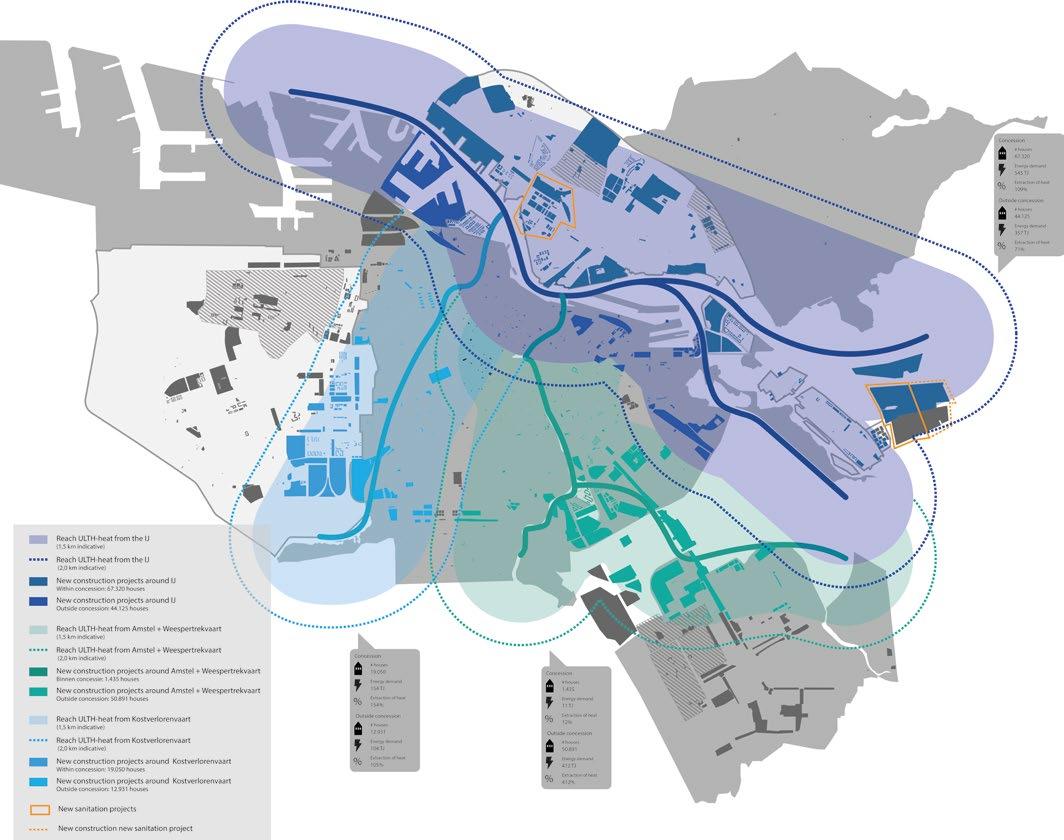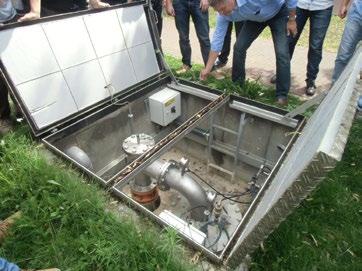
3 minute read
Existing and potential ULTHheat sources: ATES
Existing and potential sources with ULT heat: ATES
Background
Advertisement
ATES - existing
Strictly speaking, ATES is not a source but a storage medium. The word "source" is used in this context as "well" because the system consists of one or more cold and hot wells (up to the aquifer bottom layer) in the subsoil. A pipe system connects the sources. This allows groundwater to be pumped from one source to another. The heat exchanger draws energy from the groundwater flow. It usually concerns a depth of approximately 200 meters.
In winter, an ATES system provides heat to a building. The subsurface heat is stored throughout summer and upgraded by electric heat pumps. The chilled water of the winter season is stored in the cold source and can be used in the summer to cool the building. In practice, this technique allows savings of 95% on cooling and 40-50% on heating. An ATES can be constructed for a single home, but also for a complete residential block. A larger size entails scale advantages (economies of scale). Collective planning is essential for optimal use of scarce space in the subsoil. We don’t want a situation of: ‘first come, first serve’ leading to a small group of users that utilise all the potential. An ATES stores heat / cold in the subsurface and to some extent functions as a battery for energy storage.
It is not permitted in the Netherlands to pump up groundwater without a permit. The website: WKOtool.nl can be consulted if you have any questions about a permit requirement. When several ATES sources are located close to each other in the subsurface, interference is possible where the sources can negatively influence each other's temperature. In ‘interference areas’ the locations of the sources are coordinated so that there is little to no interference between the hot and cold sources.
Achieving a thermal balance with ATES systems is important. If the heat and cold needs of the connected buildings are roughly the same, the ATES is in balance. The heat demand = cold supply and cold demand = heat supply. If the heat demand over the year is higher than the cold demand (eg in houses), then regeneration of the heat source is required. Heat from other (thermal energy) sources, like surface water, can then be added. If the cold demand is higher than the heat demand (e.g. in office buildings) then the cold source must be supplemented or regenerated with an external cold source. The coupling of several ATES sources ensures a better balance and exchange of energy. Background and Long term perspective
Tme
High: 760 TJ * The Amsterdam open soil systems supply 640 TJ of energy on 596 places in the city. In addition, 112 closed soil systems also supply 120 TJ (indicative) of energy.
Low: 640 TJ * The Amsterdam ATES systems supply 640 TJ of energy at 596 locations in the city; it is not clear how many buildings are connected to these.

ATES - practical and potential
An area with a diameter of 5 km can generate an average of 20,000-25,000 TJ per year in energy from the Amsterdam subsurface. This makes Amsterdam very suitable for ATES sources. The city is (for this study) divided into five capacity areas. The energy from the shallow subsurface is 100,000-125,000 TJ. Within these areas, there is a maximum planning capacity of 283,000 new-build homes. If these were all built, it would represent an energy requirement of 2,292 TJ. That is only about 2% of the available capacity of the soil.
* Source: Grand Design warmte MRA en TNO bronnenlijst ** Source: Interpretatie TNO bronnenlijst *** Source: Energieatlas, Amsterdam Zuidoost **** Source: CE Delft studie, Nationaal potentieel van aquathermie ***** Source: Interpretatie *,***, **** en Koers 2025 Energy
Energy
Time
High: 2,300 TJ ***** All new-build homes in Amsterdam are connected to a soil source with ATES.
Low: 460 TJ ***** 20% of new-build homes in Amsterdam are connected to a soil source with ATES.
Potential: 125,000 TJ ****
Practical: 108,000 TJ *** Total heat-cold storage capacity of the Amsterdam shallow subsurface Technically recoverable energy after yield losses due to other reduction factors. The total heat demand of the entire plan capacity for new-build homes (283,000).

